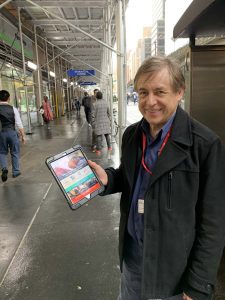October 31st was an exciting day for the =mc consulting team, testing out various decision science principles on behalf of MSF/DWB with a brilliant group of young Face to Face canvassers from GiveBridge.
October 31st was also Halloween- a big thing in NYC- so we used some themed ideas connected to the festival. The purpose? =mc consulting is building up a bank of robust field experiments designed to test the direct impact of decision science on fundraising- building on the work in Change for Good.
In the morning my colleague Alan Hudson and I offered training in Decision Science to the talented team of young smart canvassers. The team of 23 then split into four and headed for different parts of the city. Once on site they had to combine their normal successful F2F approach + one extra element from four experimental approaches to track the impact.
As serious researchers we joined one of the teams outside Grand Central Station and actually took part in the fundraising.
The four experiments, and the underlying principles we tested, are below:
Experiment 1: Principle- Anchoring
One team approached prospects and introduced a specific number into the conversation- either by standing near a sign with a number in it or by mentioning a number- e.g. “hooray it’s- 31st October Halloween.”
Idea is to see the impact of the ‘anchoring’ a number on average monthly gift among those who sign up. (See photo below where we were using the street number- 43- as an anchor.)
Experiment 2: Principle- Reciprocity
Another team approached prospects and offered them a candy- a mini Mars bar-upfront, mentioning ‘trick or treat.’ The person can keep the candy regardless if they donate or not, but they obviously need to stop or at least pause to get it.
Here we were looking for the impact of Cialdini’s reciprocity: “I give you something, so you have to give me something back” We were looking at the impact on numbers of people giving.
Experiment 3: Principle- Normalisation
Team three were asked to mention to anyone who stopped how this street/location seemed “generous- lots of people stopping and donating.”
Here we’re exploring how to make stopping appear ‘normal.’ Of course normally most people walk on past the canvassers. We were interested to see how normalisation affected sign ups.
Experiment 4: Principle- Salience/Agency
Last team were asked not to talk about ‘millions in need in Yemen’- t heir normal script- and instead focus on one child ‘Yusef’ and how $35 would help him get the drugs and treatment he urgently needed. (And how every month there was another Yusef in need.)
Exploring here how to make a huge crisis in Yemen seem solvable and concrete. NB we were also testing having no picture of ‘Yusef’ to show- allowing prospect to create their own image.)
Can you predict the outcome?
Can you work out which one produced the ‘best’ result? Specifically:
- which do you think had the biggest effect among Principles 2, 3 and 4 on numbers of sign ups?
- and for Principle 1, what do you think was the average gift when 43 was used as an anchor?
 Thanks to all who helped especially the great folks from GiveBridge. And super special thanks to Thomas Kurmann, Fundraising Director of Doctors without Borders USA, for making it happen.
Thanks to all who helped especially the great folks from GiveBridge. And super special thanks to Thomas Kurmann, Fundraising Director of Doctors without Borders USA, for making it happen.
Let me know if you want to know more bernardross@mc.consulting.




